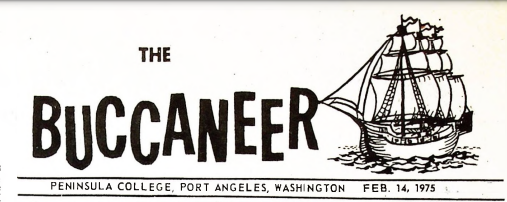
Tidepools may drown
“Tidepools,” the campus
literary magazine, may not be
published for a second year
unless there is immediate
student involvement, according
to its advisor, Miss Marjorie
Avalon.
“Unless the students want it,
they just might as well wait
until they do want it,” she said.
“It is important to start right
away to get something out this
year. However, they could work
on one for next year.”
“It takes work,” MisS Avalon
added. “Some years I would
force it through, but that was
not really justified. It should be
something a small group of
interested students could work
on.”
Last year’s issue didn’t get
typed in time. Most of the
students who contributed their
work are gone now. The
spring’s creative writing course
and the 103 short story classes
have been the main sources of
material.
Any interested student should
see Miss Avalon right away.
CSC advises limits on Studium credits
Studium Generale and related
programs consumed much of
the Community Service
Committee meeting held
Wednesday, Feb. 5.
In a unanimous decision, a
recommendation was passed to
advise the Instructional Council
to allow up to and including six
Studium Generale credits as
elective transferable credits.
This recommendation came
from concern that people who
attend PC for more than two
years could use Studium
Generale to build up easy
credits.
A review of fall quarter
Studium Generale showed 208
persons enrolled, and three
noon programs were repeated
as evening performances.
The committee completed
plans for presenting the
Contemporary Ballet program
to be held Tuesday noon and
evening, March 4. Admission
was set at $2 for adults, $1 for
students, and 75 cents for
students with an ASB or
Studium Generale card.
The committee approved
sponsorship of a special evening
version of Jack Zaccardo’s
Studium Generale program,
“Early Logging on the Olympic
Peninsula.” The program will
be presented at some mutually
convenient date after the March
4 ballet.
Double feature coming Friday
“Cool Hand Luke” and
“Rebel Without a Cause” will
be shown in a double-feature
Friday, Feb. 21, at 7 p.m. in the
Little Theater.
Set in the deep South, “Cool
Hand Luke” tells the story of a
prisoner defying the authorities
in a harshly disciplined chain
gang. Paul Newman won an
Academy Award nomination for
best actor in his portrayal of
Luke. George Kennedy won the
Academy Award for best
supporting actor.
“Rebel Without a Cause”
stars James Dean and Natalie
Wood. It tells about a young
man unable to accept his
parents’ world. It received an
Academy Award nomination for
best motion picture story.
Likens to read poetry
Ms. Barbara Likens,
communications disorder
specialist for Port Angeles
Public Schools, will read her
poetry Feb. 18 at noon in the
Little Theater.
She published her first book of
poems, “Frith,” in 1961 and is
working on a second. She is also
collaborating on a series of
children’s stories from her
experiences while building a
home in the mountains and her
life with her 12-year-old adopted
daughter.
After working with persons
with speech and hearing
problems, Ms. Likens became
involved with the retarded. As
the membership chairman for
the Washington Association for
Retarded Children, she
received the Outstanding
Achievement Award from the
Clallam County Chapter for
outstanding professional
services.
She holds a master’s degree
in education and speech
pathology from the University
of Washington and has taught
English, speech and drama for
ten years. She has a citation for
her work in creative drama
with Seattle ghetto students.
‘American dream’ turns sour for Kenya student
By JEFF BIALIK
In a day and age of human
understanding, relaxed
prejudice, and an awareness of
personal civil rights; it doesn’t
seem right that one man or one
family could possibly be
allowed to ruin the life of a
human being, or possibly the
reputation of an entire nation.
For Chris Kihika the American
Dream turned against him,
leaving only hopes in place of
what was once reality.
Chris came to PC from Kenya
sponsored by an American
family, agreeing to work on the
farm of the sponsor. Chris had
had hopes. His brother Zeke had
lived on a farm near Sequim,
had attended Sequim High
School, W.S.U., and finally had
returned to Kenya to work on a
game farm. Chris had had
hopesfor a similar return on his
investment. What he got.
though, he hadn’t bargained for.
Shortly after coming to PC in
fall of 1974, Chris came to Jim
Lunt, director of student
activities, with a problem. It
seems he had been requested by
his sponsor “parents” to clear
the table after an evening meal.
The family left the house, so
Chris was left alone to handle
the task.
Wanting to do things correctly
and as an American would,
Chris placed the food in the
freezer so it wouldn’t spoil, but
when he placed the dishes in the
dishwasher and turned it on, he
found that the dishes broke.
When the sponsor family
returned to the house they were
less than understanding with
Chris. Their only reasoning was
that Chris was a trouble maker.
Chris did not understand. In
Kenya he had never had a
refrigerator or dishwasher
Jim Lunt offered to help, but
Chrisfelt the problem was over,
as he had learned a valuable
lesson.
Chris wasn’t right, though, as
on New Year’s Day Mr. Lunt
received a call from the sponsor
family. The man informed him
that Chris just wasn’t working
out and he was preparing to
have Chris sent back to Kenya.
Mr. Lunt managed to get the
man to hold off his
arrangements, while he tried to
arrange somewhere for Chris to
live so he could finish school.
Mr. Lunt went to work. He
managed to get the PC food
manager to agree to give Chris
a week’s free food. Another
foreign student agreed to let
Chris stay with him, and
between the foreign students
and himself, Mr. Lunt had
raised Chris’ tuition fees for
winter quarter.
The actions were not merely
warranted by sympathy.
According to Mr. Lunt, Chris
had been the most successful
first quarter foreign student PC
ever had. Talking with Chris it
was also apparent that he could
work out his problems, if only
given a chance. Any foreign
student coming to a strange
country needs understanding
and time to adjust.
Without warning, however,
the roof fell in. When Chris
failed to show at school to start
the quarter Mr. Lunt called the
sponsor family. The sponsor
informed Mr. Lunt that he had
shipped Chris back to Kenya.
The problem had been
“solved”. . . by simply getting
rid of the cause.
Chris has since written a
letter to the ASB requesting any
possible help the school might
be able to offer. Chris has had
some difficulty in explaining to
his countrymen why he failed in
America. He feels his life and
career have been ruined. It is
difficult to attend a Kenyan
University, so Chris’ only hope
is to return to the States.
His biggest problem now is
money. Chris has earned
enough of the right credits to
grant admission to most any
institution of higher learning,
but he lacks $900 worth of air
fare to return.
Chrisis confused and hurt. He
needs help. It is unfortunate
that the American way seemed
to turn against him. It seems
even more unfortunate that one
American family had the right
to pass judgment and sentence,
and send an accomplished
scholar back to begin all over
again.
Editorial
Tuition hike explained
Washington’s Council on Higher Education has
prepared a plan which, If approved by the Legislature,
will increase tuition at all state colleges and universities.
Before you take a definite stand for or against the
proposal, you should review both sides of the issue.
First, look at what the CHE is presenting and why.
The plan is broken up into six categories, all of which
are based on past CHE policies. The recommendations include: (1) the present “mixed” system
of financing higher education should be continued. (2)
student charges should be kept as low as can support
quality educational programs. (3) any increase in
tuition and fees should be accompanied by an appropriate increase In student aid in order to maintain
the open-door enrollment policy. (4) fees should be
consistent with the difference in cost of education at
various levels of study. (5) reduce or eliminate
inequities in fees to part-time students. (6) nonresident undergraduate students, except those under a
reciprocal agreement, should pay fees approximating
the full cost of their instruction.
The CHE explains that adoption of these policies and
continuation of other existing policies will preserve
Washington’s strong higher education program,
regardless of the student’s financial state.
Getting down to the actual dollar Increases in tuition
and fees, the figure most PC students will be most
concerned about Is the raise in resident community
college tuition. Under this plan, tuition for this group
will go from the present $249 to $330 per year, a 32.5
per cent increase. Non-resident community college
tuition will go from $681 to $1200 per year, a 76 per cent
increase.
Going up the scholastic ladder, graduates from PC
enrolling as juniors In a state college can expect a 17
per cent increase, from $507 to $594. Students enrolling
as juniors at a state university can anticipate a 21 per
cent Increase, from $564 to $684 per year. Vietnam
veterans’ tuition and fees will be set at a standard of 85
per cent of those charged to resident students.
According to the CHE, these recommended rate
increases are based on inflationary adjustments since
tuition was last raised in 1971-72. Apparently, due to
the vast differences in percentages of the increases,
either tuition rates were not indicative of actual costs
in 1971, or if they were, the proposed raises will alter
that equality because inflation could not have raised
over 32 per cent at community colleges while only
going up 17 per cent at state colleges.
This plan, If adopted by the state legislature will
boost state revenues $22.6 million, according to CHE
figures, and should be Included in the governor’s fiscal
program for the 1975-77 biennium.
—Ed Mund
Editor’s note: This Is the first of two editorials
which will appear on the subject of the Council on
Higher Education’s legislative proposal to increase
tuition and fees for post-secondary education In
Washington State. The above editorial outlines the
CHE’s proposal, while the second will present the
arguments for and against.)
BOC falling down on job
The continual problem of a child day care center has
posed a number of interesting problems for just about
everyone at Peninsula. The BOC is so wrapped up in
the hassle that it seems to devote all of Its energies to
arguing about It and accomplishing little else. This
was evident In the BOC meeting of Feb. 4.
The group was to consider applications for three
vacant positions on the board. As the applicants were
being questioned on their qualifications for these
positions, the question that was Invariably asked was,
“What is your position on the day care center?”
Thus, the candidate was to state his position and
open himself to support or criticism among the
warring factions in the student government. The
applicant’s admission was not to be based upon his
qualifications to represent the students, but on his
position on this issue.
Fortunately this question was deleted from later
interviews, but it pointed out a serious problem within
the BOC. The students of this college did not elect
representatives and allocate money to a student
government that seems intent upon playing power
politics. We elected these people to perform a service
for us and, at the moment, this service is not being
given.
Only one member of this group seems to be performing any service to the students, Vice President
Jeff Pope. But his duties are stated within the constitution and he merely performs them. It has been
charged, and with some lucidity, that Pope is not
doing anything creative within his capacity as vice
president. But the sad fact is that Jeff is the only
member on the board who is doing anything.
This one issue has completely immobilized the BOC.
Students supporting the center have accused faculty
members opposed to it of being “pompous bastards.”
Faculty members have charged that the center is
being supported only by those people who benefit
most—mainly those who feel that they would have the
opportunity to get a job if the center is established.
Anyone who had any sense would realize that, at the
moment, the question is academic. Funds for
the project cannot be allocated at the present and
cannot be until spring.
Let’s get the lead out and urge the BOC, our
government, to stop their petty quarreling and do
something worthwhile—now.
—Brian Fink
‘M’ questions lynching
Can a lynching ever be right?
We emphatically answer, no!
But producer Fritz Lang will
force you to think about this
question in his first sound film
“M,” which was shown to the
Art of Film Class on Feb. 3.
For Americans, lynching
calls up visions of frontiersmen
at a “necktie party” or southern
whites keeping the black person
“in his place.” The film “M,”
however, takes place in a
German city in 1930.
This was popular American
film star Peter Lorre’s first
film. Lorre plays M, the
demented child murderer who
becomes the object of a lynch
mob’s wrath. The story depicts
the frustration ofthe police over
the murders of children in the
City ofBerlin. They try to detect
a pattern which will lead to the
murderer’s capture.
Pursuit of some clues
supplied by street beggars
drives M into the hands of an
underworld mob whose
aversion to the child murderer
equals that of the police. They
decide to hold a “trial” in order
to determine whether or not to
turn M over to legal authorities.
They even provide a “defense
attorney” who spells out
alternative considerations.
Although the lynch mob
prevailed following the “trial,”
the police arrived just in time to
snatch M from their violence.
This film, which was made in
Germany in 1930, gives us an
idea of living conditions in
Berlin then. In it Fritz Lang,
who went to Hollywood four
years later, experimented
creatively with the then
relatively new factor of sound in
the film media. His work can be
said to have advanced film art
considerably in this respect.
The film is in the German
language, of course, so
subtitling is necessary for
American audiences. Here is an
art which in itself does not
necessarily strive to reproduce
direct translation. It seeks,
rather, to give the viewer
impressions essential to the
story. This might be amusing to
anyone who understands both
languages.
After seeing M, the viewer is
still puzzled over the question,
“Did the good guys win?”
—Paul Meinke
Library Corner
Bytne Library Staff
“Haunted Britain; A Guide
To Supernatural Sites,” by
Anthony D. Hippisley Coxe, is
the first comprehensive guide to
a vast number of places
connected with ghosts,
hauntings, witchcraft,
mysteries, strange customs and
legends. It located wishing
wells, sites of buried treasure
and the supernatural
showplaces of England,
Scotland and Wales, and is the
ideal vade mecum for the
visitor in search of the off beat
and the eerie.
“Haunted Britain” is not
merely a secondhand record of
mysterious happenings and
spooky stories; the author has
traveled widely in Britain and
visited most of the places
described. In addition to the
many personal experiences
recounted, there is even more
immediate evidence of
hauntings.
While checking sites in
Bristol, the author’s wife saw
the ghost of a man in broad
daylight, and the photographer
was overcome by such a sense
of evil at Saddell Abbey that he
could not bear to stay longer
than a few minutes.
The use of such hallucinogens
is likely to become more
common and the furor over
their use will probably
diminish. Legalization of some
drugs is a fact already
confronting us. This excellent
book discusses the relationship
between drugs and the’
incidence of psychosis, as well
as their influence on the
viability of chromosomes, thus
touching upon the vast subject
of hereditary defects.
“Any Old Way You Choose It:
Rock and Other Pop Music,
1967-1973,” by Robert
Christgau. Here is rock music
as both social phenomenon and
artistic achievement. In
discussing its social aspects,
Robert Christgau investigates
rock music’s appeal to its
audience. In examining its
achievement, he evaluates its
worth as art and as invention.
Among much else, Christgau
looks at the beginnings of rock,
the extra-musiqal themes that
are bound up in it (especially
sexism and politics), the
significance of individual
artists, and the meaning of
current trends.
The result is a book that
ranges from the days of flower
power to the new androgyny
and covers an extraordinary
variety of performers, among
them Chuck Berry, Bob Dylan,
the Rolling Stones, the Beatles,
Grand Funk Railroad, Bette
Midler, and the New York Dolls.
WSU rep here Feb. 26
Jesse Welch, a representative
from Washington State
University will be on campus
Wednesday, Feb. 26, to offer
information to students
interested in that school.
Students are advised that the
representative will be here
from 9 a.m. until noon.
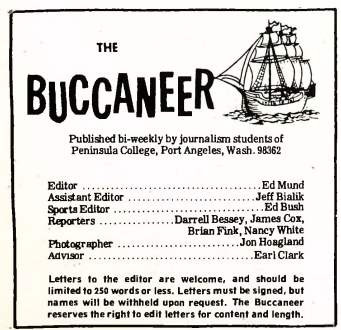
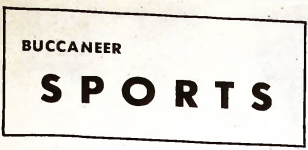
Sport car rally held Sunday
Last Sunday afternoon,
Olympic Sports Car Association
held a car gymkhana in the
college parking lot.
The gymkhana consisted for
four events in which drivers
could enter their cars to win
awards for members and nonmembers.
Ten cars entered the events,
ranging from a 1950 Ford
pickup and V.W. to Triumphs
and MGB’s.
Starting the events was blindman’s buff, in which the driver
is blindfolded and the passenger
is supposed to direct the driver
through a maze of cones. One
driver got a little excited and
zigged when he should have
zagged and ran his Opel G.T.
onto a curb near the course.
Luckily enough people were on
hand to lift him off.
Second was the look but don’t
touch event. Drivers try to stop
as close as they can to a barrel
without touching it. Former
P.C. student Greg Mackey won
the event, coming within threefourths of an inch of the barrel.
The $10 coverup seemed to be
the hardest event to master, as
drivers tried to cover $10 bill
with their front right tire, the
winner to get the ten bucks.
Unfortunately, no one was
successful.
Last was the pop-in good time
event. Again a maze of cones
was set up, with balloons
attached to them. The
passenger of the car in this
event is equipped with a stick
with a pin at one end, to pop the
balloons in the shortest amount
of time. Again Greg Mackey
took a first as he crossed the
finish line with the quickest
time.
Those interested in the club or
who would like to participate in
the events may call Larry
McLean at 683-5188.
Campus sport scene
Better luck next year
By ED BUSH
In the hard pressed times of today’s world, one tries to save
money whenever possible.
There has been some talk of limiting the budget alloted to
the sports programs of Peninsula College. For those who feel
this way, I offer my opinion on a way to reduce spending in
the sports field.
Let’s take a look at girls basketball. It was initiated at
Peninsula because enough girls were interested in playing on
a competitive basis with other schools. This year however,
the competitive nature has disappeared along with the
money for the sport.
In all, the girls have played five games including a long
road trip to play Clark College losing 86-14) in which the girls
received $11 each for food and perfume. This figure equalled
that which the boys basketball team received.
To start the season, the girls played Highline College and
lost 78-7. This was a sneak preview of how the rest of the
season was to go. Peninsula’s opponents have scored 330
points in the five games they have played, while Peninsula
has scored a mere 77 points. This averages out to 66 points
per game for the opponents and 15.4 for Peninsula, a spread
of 50.6 points per game.
Should such a program be allowed to devour precious
money of the sports budget? If not to save money, at least to
save embarrassment of the girls and the school.
I feel that girls basketball at P.C. should come to a halt for
this season, before any more money is poured down the
drain. That money which is left should be used to support
girls basketball in future years.
Girls basketball should come about after and only after
enough money has been saved or allotted to produce a good
program. This would include a full time coach, one who
would return each year and have some knowledge of the
game. Also recruits from out of town. You can’t expect to
compete with other collegeswith just the girlsfrom P.A.
The girls should follow the same route the boys baseball
team did last year. WITHDRAW!!!!
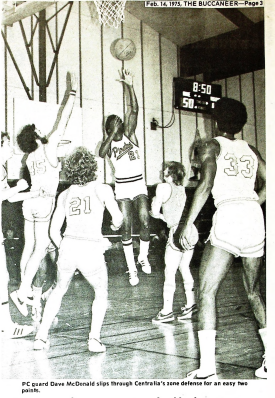
Pirates lose twin bill, hopes
By J IM COX
The Peninsula Pirates
virtually lost their slim play-off
hopes as they suffered back-toback defeats on their home
court, losing first to the
Centralia Blazers in overtime
75-65, and then falling to
Highline, 79-68.
The Pirates met Centralia in
a midweek contest on
Wednesday, Feb. 5, and started
the game poorly, falling behind
10-1 before making a comeback
which saw them down by only
one point at half time, 29-28.
The second half was a see-saw
battle which saw the lead
change hands six times, but the
Pirates managed to hold a
seemingly adequate lead of
seven points, 61-54 with only
3:01 remaining in the game
until the momentum changed
hands, boosting Centralia to
fight back to a 61-61 tie with 1:15
left. After a missed Peninsula
shot attempt, Centralia went
into a stall, enabling them to
take the final shot of regulation
play which missed.
The overtime period proved
to be disastrous for Peninsula
as they were outscored 14-4 by
the Blazers, who were again
running a slowdown style of
play. The win boosted
Centralia’s record to 6-5, and
dropped Peninsula’s to 4-6. The
Pirates blew a golden
opportunity to gain ground on
league leading Mt. Hood, which
was upset by Lower Columbia
79-65.
The Highline Thunderbirds,
coming to town with a fresh loss
to Olympic College, 81-74 the
game before, were the Pirates’
next foe. The Thunderbirds
continued their success, against
the Pirates, defeating them 79-
68 in a game in which the
Pirates were cold, from the
field.
Highline played an
aggressive game on the boards,
and combined with the costly
Pirate turnovers and cold
shooting (29 for 70) from the
field, kept the Pirate scoring
low. The Peninsula backcourt
men, Dave McDonald and Tim
Fryer, were held well below
their averages, and Peninsula
needs good scoring from these
key men to win most contests.
The loss dropped Peninsula to
a league record of 4-7, and
practically shattered any
Pirate play-off hopes.

PC trains future fisheries aides
By EDMUND
Peninsula College’s
vocational program covers
several occupations, not the
least of which is fisheries.
The PC fisheries program is a
comprehensive two-year course
designed to train students to be
“fisheries technicians.”
According to the PC
catalogue “this program
prepares a student to perform
assignments as a scientific or
biologist.” Upon completion of
the program, the student is
awarded th an Associate of
Applied xxrts degree, and a
fisheries certificate.
Three men make up the
faculty. Dick Grinds, Robert
Mausolf and Don Well.
Mr. Grinols came to PC in 1968. He received his B.S., M.S.,
and additional graduate work
from the University of
Washington.
Mr. Mausolf has been
teaching at PC since 1964. He
also holds a B.S. degree from
the U.W.
Mr. Well received his B.S.
from Oregon State University,
and came to PC in 1965.
The first year of the program
involves learning of basic
information needed to
specialize in this field. The
curriculum is centered around
three quarters of biology and
math. Also included are two
quarters of chemistry and
technical report writing. In
addition, three quarters are
spent acquainting the students
with the routines and practices
involved in working in a fish
hatchery. Another necessary
course is taxonomy — learning
how to identify the different
species of fish.
The second year of the course
increases the scope of the
student’s learning by allowing
him to apply what he has
already learned to real
situations.
Of course, there are still more
classes to take. These include
three quarters of math and one
quarter of fish diseases, wildlife
management ? id aquatic
environment. A cc arse covering
practices used by commercial
fishermen both locally and
world-wide is also required.
Interspaced in the two-year
program are numerous field
trips to pertinent areas in the
state. These areas include
many hatcheries such as the
state-operated ones at
Hoodsport, Dungeness and
Soleduck, and the federal
operation justsouth of Quilcene.
Other points for travel are the
Graysmarsh farm north of
Sequim, Olympia, and Kalaloch
Beach. During these field trips,
students observe and
participate in activities ranging
from spawning salmon to minor
maintenance work and
inspection of facilities.
The current sophomore
fisheries class is working on
three main projects: building a
fish hatchery, outfitting a new
boat, and a general study of
Lafe Mills.
The fish hatchery is more
officially known as a freshwater
recirculation system-type
hatchery. When completed, the
system will be able to handle
either salmon or trout.
The main segment of the
hatchery will consist of three
tanks four feet in diameter
mounted on a permanent
foundation. Each tank is
capable of holding
approximately 1500 gallons of
water. Two electric pumps will
be employed to supply fresh
water to the tanks, with a
backup pump ready in case of a
power failure.
Water leaving the tanks will
be run through a filtration tank,
full of crushed oyster shells and
rocks. Nitrifying bacteria grow
in this tank and attach
themselves to the oyster shells.
Thewaste products in the water
are consumed by these
bacteria.
The water is then pumped
through an aeration tank where
it is re-oxygenated, then
returned to the main tanks. A
small amount of fresh water
will be constantly added to the
system to compensate tor any
loss that occurs.
Nearly all construction on the
16’x32’ hatchery will be done by
students and faculty, but
outside help will be sought
when it comes to enclosing the
facility.
Construction was started on
the hatchery during fall quarter
of 1973. It is expected to be
completed before the end of the
1974-75 school year.
An 18-foot open workboat was
purchased by the school for the
fisheries program during
winter quarter of 1974 for $1,600.
This also included a trailer. The
program was given a budget
with which to outfit the boat for
fisheries use. Modifications to
the boat include a new 65 hp.
outboard motor, engine and
steering controls, tachometer,
speedometer, and water
temperature gauge. Also added
were a convertible top,
windshield, fathometer and
navigation lights. The boat will
carry a five-man crew,
including four students and one
teacher.
The new boat will see
extensive use during the Lake
Mills project. Lake Mills is
located on the Elwha River
behind the Gline’s Canyon dam.
The task of the students is to
complete a general survey of
the lake for the State
Department of Fisheries and
the National Park Service.
Included in this survey is a
history of the lake to be
gathered by study of past
hydrographic surveys of the
bottom and flow charts for the
dam.
In addition, a new map of the
contour ofthe lake’s bottom will
be made using the fathometer
on the new boat, this will show
any changesthat have occurred
in the depth and shape of the
bottom since the last chart was
made in the 1930s.
Also included in the general
project is an extensive survey of
native fish in the lake. This
survey will examine the various
species of fish found in the lake
and estimate their popuations.
The survey will also provide
data on the feeding habits, size
and age of the fish.
The survey is being conducted
with the help of four gillnets
supplied to the class by the
State Department of Fisheries.
Once the student has
completed the two-year
program and received his
certificate, there are many
areas of possible employment
open for investigation.
On the national level are fish
hatcheries run by the
Department of the Interior all
over the United States, the
closest one located just south of
Quilcene.
On the state level, the
Department of Fisheries and
the Department of Fish and
Game are possible sources of
employment. The Department
of Fisheries isin charge of more
than 60 hatcheries throughout
the state.
The Game Department
controls the Shellfish
Laboratory on Hood Canal, and
maintainsthe fisheries patrol to
police both commercial and
sports fishermen. In addition, it
does extensive research work
on such topics as migration of
fish and fish diseases.
Private corporations are also
active in fisheriesresearch. The
latest example is the upsurge in
interest over aquaculture.
While not much activity is
seen going on around the
fisheries building located on the
south side of the campus, those
students are really working for
their credits.
Although fisheries
technicians, aides to biologists,
hatchery workers and persons
involved in fisheries
management are needed if
problems of lake and stream
pollution and continued fish
production are to be met head
on, imployment opportunities
are slim.
Instructors Mausolf and Well
estimate that less than 50 per
cent of the students completing
the fisheries program will be
hired in fisheries.
The state and federal
governments have pulled most
of the funding from fishery
studies, where most of the
hiring comes from. When
Peninsula’s program began 10
years ago the demand for
trained personsto participate in
the gathering of data and basic
research of government studies
could not be satisfied.
Mr. Well summed up the
current situation by saying, “It
can only get better.”
Playoff champ to be named
With the cancellation of
intramural basketball,
Intramural Director Jon
Livingston initiated a
tournament involving the top
teams of the shortened season.
Despite many rumors that the
winner of this tournament
would be named intramural
basketball champions, first
place has already been awarded
to the Big Thrills based on their
top won-lost record.
With all the games played in
the tournament up to this point,
it appears that the Nummies
will be in the finals against the
winner of -the Drop-Ins—Big
Thrills game. However, a
protest filed against the
Nummies is pending, which
could greatly alter things. The
protest was filed by the captain
of the Looney Bins in their
tournament game against the
Nummies, on the basis that the
Nummies have been using an
excessive number of players on
their roster.
The Intramural free-throw
match held Friday, Feb. 7, was
won by Jerry Allen, who sank 23
of 25 attempts to capture the
first place trophy.
Coming events in intramurals
are bowling and table tennis.
Check the intramural board for
signup dates.
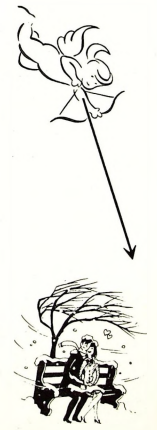
PC Players provide sterling performance
By EDMUND
Peninsula College and Port
Angeles were treated to three
fine performances by the PC
Players in their production of
“The Enchanted.”
The play involves the life of a
young girl struggling against
pressures from the community,
from a young man, and from the
spiritual world in an effort to
decide which life she wants to
lead as she goes from girlhood
to womanhood.
She attempts to entice the
town’sresident ghost to help her
bring back all the dead souls to
the living world so that they can
demonstrate to living people
how artificial and unimportant
the real world is.
Fortunately for all of us, she
is persuaded away from this
viewpoint and she and the
supervisor of weights and
measures decide to get married
and live happily ever after.
The role of Isabel, the girl
with all the troublesome
decisions to make, was more
than adequately portrayed by
Mary Pearce and Kara
Slehofer, who alternated for the
three performances.
They were backed up by
Jerome Eberharter as the
ghost, Mike Blunk as the
supervisor, Charles Lukey as
the inspector, Lee Cain as the
mayor, and Harold Walters as
the doctor.
More specifically, possibly
the most sterling performance
next to that of Isabel would have
to be Chuck Lukey as the
inspector. Lukey managed to
overcome the major problem
plaguing actors with an excess
of lines, that of keeping the
audience with you. He carried
off even the longest speeches
with such an air of perfection
that he managed to hold the
audience’s attention.
Other individual
performances worthy of special
note were those of the mayor
and the doctor. Although he
didn’t have too many lines, Lee
Cain managed to produce a
definite and believable
character of the mayor through
body movements and
particularly facial gestures.
No review of this play would
be complete without some
mention of “the little girls,”
Lisa Hitt, Debbie Anderson,
Patrea Hitt and Nancy White.
They added a spark of life to
some scenes that otherwise
might have been deadly dull
and in general added to the
tempo of the whole play.
From a production standpoint
the play was almost flawless.
The lighting and scene changes
were executed with absolute
precision. The only apparent
flaw was a tendency to be a bit
heavy handed on the volume for
the sound effects and
intermission music.
After such a fine performance
by the PC Players in “The
Enchanted,” hopefully they will
consider doing another
performance after the play now
coming up at the Community
Playhouse.
